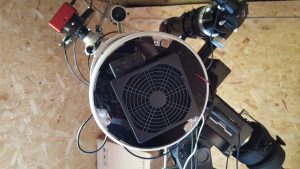After much deliberation and conversations back and forth with Bernard at Modern Astronomy, I finally decided to go for the Skywatcher Quattro 8-CF 8” F4 Reflector, there was a number of factors that helped me reach this decision, most of it was the British weather being so unpredictable that I needed to get as many photons for my images in the shortest available time. I was used to imaging at F7.5 that the F4 was going to give me significantly faster optics, I also opted for the Carbon Fiber version purely from a thermal expansion perspective as it was going to perform better than the steel tube version. I also opted for the 8” as the Native focal length of 800mm suited me perfectly, and I plan on getting the Keller reducer to bring it down to 560mm at F2.8.
Setup and Collimation
When I received my telescope and optically matched Aplanatic Coma Corrector, I was impressed with the build quality of the scope itself, internal baffles to boost contrast as well as eliminate stray light, and the focuser is pretty sturdy for a stock focuser, and quite easily handles the weight of my CCD and Filterwheel. I mounted the telescope next to my Guide scope on my Skywatcher EQ8, I wish they had provided a Losmandy plate with the telescope, but the Vixen style bar still worked out well. After balancing the scopes on the mount I was ready to check the collimation, for this I used my Farpoint Collimation Kit, firstly the laser to ensure it hits the centre spot of the primary, and the laser return reached the centre point of the laser collimator itself, the adjustments required were very minor. After this I verified the collimation with the Farpoint Cheshire and it verified that the collimation was correct, only thing left to do was a star test, for this I used a 10mm Eyepiece and a fairly bright defocused star, the star was spot on, I could see all the concentric rings. I then proceeded to perform the same star test with the CCD and the Aplanatic Corrector to verify, which of course it did.
Scope Details:
Focal Length: 800mm
Apperture: 8 Inch
Focal Ratio: F4
Tube Composition: Carbon Fiber
Focuser: 2″ Dual Speed Linear Power Focuser
First light
My first target for 2016 is the Iris Nebula, my first set of frames came through and for a 5 minute exposure I was impressed with how much data I had collected, data that would have taken over 15 minutes to collect on the F7.5 refractor I now use as a guide scope, I managed to finish a target off within a few days of imaging rather than over a multitude of nights
I have also not had to re-collimate the scope or adjust the focuser on the scope over the few weeks I have had it, so overall I am above and beyond happy with my decision and I am now able to image targets in a shorter timeframe which in the UK you have to grab every clear sky you can
A few months on
I have had to re-collimate the scope 0 times, even after removing the primary mirror assemply for cleaning, the focuser is still rock solid and holds the camera gear extremely well.  I have made an addition to the scope, I have added a fan system to the rear of the primary mirror, the fan also has some nichrome wire which allows the air being blown around the primary to be just above the dew point which prevents dew forming on the primary and believe it or not the secondary also, even in high humidity sessions.
I have made an addition to the scope, I have added a fan system to the rear of the primary mirror, the fan also has some nichrome wire which allows the air being blown around the primary to be just above the dew point which prevents dew forming on the primary and believe it or not the secondary also, even in high humidity sessions.
Build Quality: Extremely pleased with the build quality of the scope, even the focuser is sturdy and holds all of my gear really well
Collimation: Extremely easy with the right tools, it has required no further collimation in the months that I have now owned the scope
Improvements: Could have come with a fan assembly, most of the other F4 scopes from other vendors do
Conclusion
After months of usage, I have produced some really good images in short timeframes due to the fast F4 ratio, I am looking forward to using this scope again next season with 3nm NarrowBand filters and possibly the Keller Reducer to bring it down to F2.8



